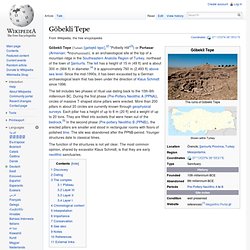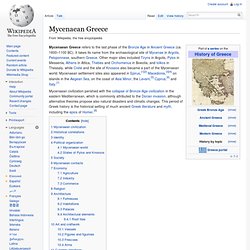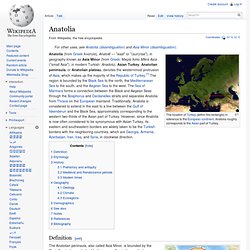

Çatalhöyük. Çatalhöyük (Turkish pronunciation: [tʃaˈtaɫhøjyc]; also Çatal Höyük and Çatal Hüyük; çatal is Turkish for "fork", höyük for "mound") was a very large Neolithic and Chalcolithic proto-city settlement in southern Anatolia, which existed from approximately 7500 BC to 5700 BC, and flourished around 7000BC.[1] It is the largest and best-preserved Neolithic site found to date.

In July 2012, it was inscribed as a UNESCO World Heritage Site.[2] Çatalhöyük is located overlooking the Konya Plain, southeast of the present-day city of Konya (ancient Iconium) in Turkey, approximately 140 km (87 mi) from the twin-coned volcano of Mount Hasan. The eastern settlement forms a mound which would have risen about 20 m (66 ft) above the plain at the time of the latest Neolithic occupation. There is also a smaller settlement mound to the west and a Byzantine settlement a few hundred meters to the east. Göbekli Tepe. The function of the structures is not yet clear.

The most common opinion, shared by excavator Klaus Schmidt, is that they are early neolithic sanctuaries. Discovery[edit] The site was first noted in a survey conducted by Istanbul University and the University of Chicago in 1963. American archaeologist Peter Benedict identified it as being possibly neolithic[6] and postulated that the Neolithic layers were topped by Byzantine and Islamic cemeteries. The survey noted numerous flints. In 1994, Klaus Schmidt, now of the German Archaeological Institute, who had previously been working at Nevalı Çori, was looking for another site to lead a dig.
The following year, he began excavating there in collaboration with the Şanlıurfa Museum. Dating[edit] View of site and excavation The imposing stratigraphy of Göbekli Tepe attests to many centuries of activity, beginning at least as early as the epipaleolithic, or Pre-Pottery Neolithic A (PPNA), in the 10th millennium BC. Mycenaean Greece. Mycenaean civilization perished with the collapse of Bronze-Age civilization in the eastern Mediterranean, which is commonly attributed to the Dorian invasion, although alternative theories propose also natural disasters and climatic changes.

This period of Greek history is the historical setting of much ancient Greek literature and myth, including the epics of Homer.[8] Mycenaean civilization[edit] Mycenaean Greece, ca. 1400–1100 BC. Mycenaean civilization originated and evolved from the society and culture of the Early and Middle Helladic periods in mainland Greece.[9] It emerged at ca. 1600 BC, when Helladic culture in mainland Greece was transformed under influences from Minoan Crete. Quite unlike the Minoans, whose society benefited from trade, the Mycenaeans advanced through conquest. Not only did the Mycenaeans defeat the Minoans, but according to later Hellenic legend they defeated Troy, presented in epic as a city-state that rivaled Mycenae in power.
Historical correlations[edit] Minoan civilization. Map of Minoan Crete The Minoan civilization was an Aegean Bronze Age civilization that arose on the island of Crete and flourished from approximately the 27th century BC to the 15th century BC.[1] It was rediscovered at the beginning of the 20th century through the work of British archaeologist Arthur Evans.

Will Durant referred to it as "the first link in the European chain. Mesopotamia. Map showing the extent of Mesopotamia Mesopotamia (from the Ancient Greek: Μεσοποταμία: "[land] between rivers"; Arabic: بلاد الرافدين (bilād al-rāfidayn); Syriac: ܒܝܬ ܢܗܪܝܢ (Beth Nahrain): "land of rivers") is a name for the area of the Tigris–Euphrates river system, corresponding to modern-day Iraq, Kuwait, the northeastern section of Syria and to a much lesser extent southeastern Turkey and smaller parts of southwestern Iran.

Widely considered to be the cradle of civilization in the West, Bronze Age Mesopotamia included Sumer and the Akkadian, Babylonian, and Assyrian empires, all native to the territory of modern-day Iraq. In the Iron Age, it was controlled by the Neo-Assyrian and Neo-Babylonian empires. The indigenous Sumerians and Akkadians (including Assyrians and Babylonians) dominated Mesopotamia from the beginning of written history (c. 3100 BC) to the fall of Babylon in 539 BC, when it was conquered by the Achaemenid Empire. Etymology Geography History Periodization Literature. Anatolia. Coordinates: Definition[edit]
